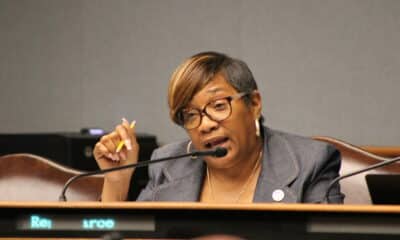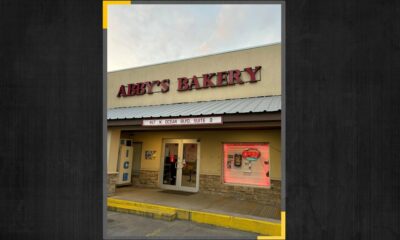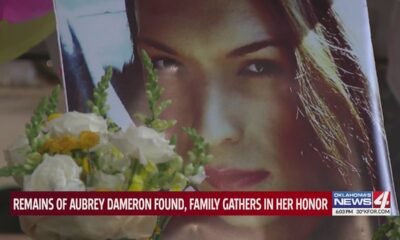Mississippi Today
It is time for Mississippi to celebrate Marjorie Baroni

Marjorie Baroni – one of Mississippi’s most courageous and committed civil rights activists – was born 100 years ago, on Aug. 16, 1924. Historians have taken note of her key role in the struggle for social justice in Natchez, but she is not well-known in her hometown. It is time to rectify that omission by celebrating her life and legacy.
During the last decade, Natchez has begun confronting its history of racism and acknowledging the individuals engaged in the civil rights struggle. Two years ago, it dedicated a monument to the more than 150 Black marchers sent to the MIssissippi State Penitentiary at Parchman in 1965 for protesting for civil rights. In 2015 the Natchez Board of Aldermen passed a resolution apologizing to those Black residents “who suffered these injustices.”
The Natchez Museum of African American History and Culture, established in 1991, and the Natchez Civil Rights Trail Committee now have partnered on a new publication that tells the story of the civil rights movement in their city. The free map of civil rights sites includes photographs and an annotated list of 53 sites along with a QR code that takes readers to the online version of the map. The map may be downloaded at: https://visitnatchez.org/wp-content/uploads/Map-of-Civil-Rights-Sites-Corrected-PDF-Mallory.pdf

This year Mississippi and the nation are marking the 60th anniversary of a key turning point in the civil rights movement, Freedom Summer, of which Baroni played a significant part.
‘You had to follow your conscience’
Marge (as she was known) hardly fits the stereotype of a white activist in the Black-led freedom movement. She was not a do-gooder or a white savior. She was a fearless activist who put herself at great risk, alongside Black Natchezians, to challenge the Jim Crow system.
She was born Majorie Rushing to poor Mississippi sharecroppers and raised in the Baptist church. As a child, she liked to read (including books like Victor Hugo’s “Les Miserables” and Charles Dickens’ “A Tale of Two Cities”) and described herself as a “dreamer” and a “romantic.”
But the harsh realities of poverty and a dysfunctional family (an alcoholic father and a stern mother) intruded on her hopes. Like her parents and five siblings, she endured the hard toil of working the land, including picking cotton. The family moved often, to different tenant shacks and farms in Natchez and Adams County. One of them was the China Grove Plantation, where the Rushings were the only white family. As a young girl, Marge recognized the racial and class differences that kept people apart, sowing the seeds for her later activism and her empathy for the victims of injustice.
After dropping out of Natchez High School during her senior year at age 17, she married 19-year-old Louis Baroni, the son of local sharecroppers from an Italian family. After moving to Connecticut and then New Orleans, where Louis found work in shipyards during World War II, they returned to Natchez and raised six children.
Marge’s intense reading and search for fulfillment led her to convert to Catholicism in 1947 and join St. Mary’s Cathedral. During the 1950s, she led a weekly book club at the church. Cathedral school invited her to speak to high school girls about her conversion.
During this period, she discovered the writings of Dorothy Day, the founder of the Catholic Worker movement, a prolific journalist and a well-known peace activist who inspired thousands of like-minded Catholics to establish homes where they lived with and served poor and homeless people. Describing Day’s influence, Baroni came to believe “you had to follow your conscience, no matter how difficult it was.” The two women soon developed an active correspondence that lasted until Day’s death in 1980. Day, who was 27 years older, occasionally visited Marge in Natchez. Marge, in turn, kept Day abreast of the Southern civil rights struggle.
A major turning point in Marge’s life occurred in 1957, while she was attending a local piano concert. Like all such public events in Natchez at the time, the concert was segregated. As she later wrote:
“The fact that (concerts and plays) were segregated became too much for me. What was I doing there? How could I justify my belief in the fatherhood of God and the brotherhood of man if I had no qualms about enjoying privilege because of the color of my skin?”
Within a few years, she quit her job as the first female editor of the Natchez Democrat, where she wrote a column on cultural and theater events, because she was no longer willing to attend segregated affairs.
“The thing is, it was perfectly acceptable for white people to sit down and talk about how black people were mistreated, so long as one didn’t do anything about it, so long as one didn’t attempt to change it,” she later recounted. “You could deplore it. You could be upset about it. You could say it was wrong. You could point to the Bible. You could read the Bible and study your religion, but you couldn’t practice it.”
Stepping up her activism
By the early 1960s, she was deeply immersed in the civil rights movement, just as the Ku Klux Klan, which had a large presence in Natchez, began terrorizing activists fighting for racial justice. In 1963, Marge volunteered with Natchez’s Freedom Campaign, which challenged the segregated Democratic Party. This effort led to Freedom Summer in 1964, as college students and others from around the country came to Mississippi to help the struggle for voting rights and desegregation.
Marge stepped up her activism. She brought supplies to Natchez’s Freedom Schools, a cornerstone of the movement’s efforts to mobilize Black citizens. She opened her house to Student Non-Violent Coordinating Committee activists to meet and lodge – a risky undertaking.
“After a year of Klan-related beatings, arsons and murders on both sides of the Mississippi River in 1964,” wrote Stanley Nelson, former editor of the Concordia Sentinel and author of several books on unsolved murders of civil rights activists, Marge “begged Monsignor Thomas Fullam, pastor of St. Mary’s Cathedral in Natchez, to ‘preach about it.’” She was devastated when he refused to do so. But she credited Father Fullam with integrating Cathedral School in 1965, a year before local public schools were desegregated.
Marge reached out to Catholic clergy and lay leaders across Mississippi and other Southern states to encourage them to address issues of racial injustice and segregation within the church. She built relationships with the Black parishioners of Natchez’s Holy Family Catholic Church and its white Josephite priests, Father William Morrissey and Father William Danahy, who offered the local NAACP space to meet at the church and who joined its clandestine meetings where they discussed strategies and tactics.
Marge was one of the few white members of Natchez’s NAACP chapter and became friends with its president, George Metcalf. Through those ties, she worked to integrate Natchez’s whites-only library and the dining room at the Eola Hotel and to help register Black voters at Holy Family..

In December 1964, she participated in a sit-in in downtown Natchez as a test of the new federal Civil Rights Act, which prohibited segregation in public accommodations. She joined the six-month-long mass boycott of Natchez’s downtown stores to protest the August 1965 bombing of Metcalf’s car by segregationists (he was seriously injured) and the city’s intransigence in addressing segregation.
She attended hearings of the Civil Rights Commission. At a meeting of the liberal Mississippi Council on Human Relations held at Tougaloo College, she met Mickey Schwerner, a Freedom Summer volunteer from New York, a month before he and two others were killed by Klansmen near Philadelphia, Mississippi.
From 1967 to 1969, Marge worked with the Catholic church and civic leaders to bring funds from the federal anti-poverty program to her hometown by creating the Adams Jefferson County Improvement Corporation. As its assistant director, Marge was on the front lines of these efforts. The agency sponsored the first local Head Start program, adult literacy programs and job training programs for high school students – white and Black. Today these programs seem like common sense, but at the time, they were controversial.
In 1969, and for the next 10 years, she went to work in Fayette, 24 miles from Natchez, as an aide to Charles Evers, a civil rights leader who had been elected the first mayor of a biracial Mississippi town.
Ostracism and death threats
All these and other efforts took a personal toll on Marge and her family. They endured death threats from the KKK, including at least one bomb attempt at their home. On several occasions, shots were fired at their house, once when Louis and their son Philip were sitting on their front porch. Louis worked at the Armstrong Tire factory, a stronghold of KKK members. His fellow white workers refused to talk or socialize with him and he feared for his life. Marge was shunned by most white parishioners at St. Mary’s church, including one-time friends.
Dorothy Day encouraged Marge to persist. In one of her letters, Day praised her “energies and desires to serve the Lord” and her “love of people and interracial justice,” observing, “You have been a voice in the wilderness and a shining light to the blind!”
Although Marge was always a voracious reader, it wasn’t until she was in her 50s that she took the time to complete her formal education. In 1982 she graduated from the University of Southern Mississippi. Over the next four years, she worked as a part-time teacher in Hattiesburg while pursuing her master’s degree from USM. This gave her the opportunity to write about her journey of faith and her involvement in the civil rights movement. For years she documented her experiences in journals, essays, letters, short stories, and autobiographical writings.
Marge was diagnosed with cancer in 1981 and died in 1986. She never finished her graduate degree. Her papers, now part of the archives at the University of Mississippi, provide a chronicle of her life, thoughts and activism and the civil rights movement. Eva Walton (now Kendrick), a graduate student at Ole Miss, mined these documents, as well as interviews, to write her own master’s thesis about Marge, which she completed in 2012.
Other scholars have written about Marge and the Natchez civil rights movement. Yet she remains unheralded in her own hometown and native state, which in recent years have been confronting their own legacy of racism and celebrating those who challenged Jim Crow. This is a good time to honor Marge Baroni for her courage, integrity, and contributions to making Natchez a more humane city and Mississippi a more inclusive state. We all stand on her shoulders.
Terry Meng, a Natchez native and a graduate of its Cathedral School, is a nurse practitioner in Pasadena, California. Peter Dreier is a professor of politics at Occidental College in Los Angeles and co-author of several books, including “The 100 Greatest Americans of the 20th Century: A Social Justice Hall of Fame”.
This article first appeared on Mississippi Today and is republished here under a Creative Commons license.![]()
Mississippi Today
Senate passes its income tax cut plan
Senate passes its income tax cut plan
The Senate voted Monday evening to pass a tax cut that reduces the state income tax and the sales tax on groceries while raising the gasoline tax, setting up negotiations with the House.
The measure passed the GOP-majority Senate 34-15, with four Democrats supporting it and four Republicans opposing it. It now heads to the House, whose leadership is advocating for its own plan, which would eventually eliminate the state individual income tax.
The Senate plan amounts to a net tax cut of $326 million, a more modest sum than the $1.1 billion net cut passed by the House. The Senate would reduce the state’s flat 4% income tax to 2.99% over four years, while the House would eliminate the income tax over more than a decade.
Senate Finance Chairman Josh Harkins, a Republican from Flowood, told reporters that the legislation was a responsible way to cut taxes while slightly increasing the gasoline tax to provide more revenue for infrastructure funding.
“I think we’ve put forward a really good plan that helps families at the grocery store by lowering the sales tax on groceries,” Harkins said. “And it provides incentives and rewards work.”
The Senate plan would reduce the state’s 7% sales tax on grocery items, the highest in the nation, to 5% starting July 2025. Municipalities receive a portion of grocery tax revenue, and the Senate plan would make cities whole.
The Senate bill would raise the state’s 18.4-cents-a-gallon gasoline excise by three cents yearly over the next three years, eventually resulting in a 27.4 cents-per-gallon gas tax at completion. This is an effort to help the Mississippi Department of Transportation with a long-running shortfall of highway maintenance money.
Most of the chamber’s Democratic members opposed the plan over fears that the state could not afford to wipe out around half a billion dollars each year from its budget and still address some of the state’s critical issues such as public education and health care.
“That’s a lot of money, and we need that money for basic infrastructure,” Democratic Sen. Hob Bryan of Amory said. “Everyone benefits from infrastructure.”
Some Democratic members attempted to amend the bill to eliminate the grocery tax or change the tax structure to avoid increasing the gas tax. But the GOP-majority chamber on party-line votes defeated the amendments.
Four Republican senators voted against the final measure because it raised the gasoline tax, something they viewed as going against the GOP’s core ideology.
Sen. Angela Burks Hill, a Republican from Picayune, told reporters the gas tax increase would hurt rural people the most because they have to drive further for work and to purchase groceries.
“I’m just trying to follow my party’s platform of low taxes,” Hill said.
Now that both chambers at the Capitol have passed separate tax proposals, the key question will be how much legislative leaders can compromise on a final package. House Speaker Jason White, a Republican from West, and Republican Gov. Tate Reeves have said abolishing the income tax is their primary goal this session.
White previously told Mississippi Today that he’s willing to compromise with the Senate, but he wants a final tax cut that’s substantive and meaningful.
“We’re not interested in a small piece of a tax cut while not addressing other issues,” White said.
Reeves has thrown cold water on the Senate’s proposal because it doesn’t entirely eliminate the income tax. If lawmakers can’t agree on a proposal, he could call them into a special session to address taxes.
Harkins, though, said he hopes lawmakers can “build consensus” on a final package during the regular session. House and Senate leaders will likely debate the measure for the next month. The deadline for lawmakers to approve tax and appropriations bills is March 31.
This article first appeared on Mississippi Today and is republished here under a Creative Commons license.![]()
Mississippi Today
City goes to the suburbs, and Germantown is the winner
City goes to the suburbs, and Germantown is the winner

Can’t tell you how many times I’ve been asked this question in recent years: What has happened to Jackson Public Schools basketball?

Good question.
And I do know the answer, at least a large part of it. But first some background.
Used to be, you could count on several JPS powerhouses to bring huge crowds to the State Tournament at Mississippi Coliseum every February to watch Murrah, Lanier, Provine, Callaway and Jim Hill teams that annually produced some of the greatest basketball talent in Mississippi history. Often, fire marshalls stepped in and locked the Coliseum doors with still hundreds of fans outside hoping to get in.
That’s no longer the case. Not a single JPS boys team made it to the State semifinals this year. (The Lanier girls will play Choctaw County in a 4A semifinal game Wednesday afternoon.) Even just a decade ago, no JPS boys teams in the State Championships would have been heresy. This is not to say that the Jackson metro area is not represented at the Big House. Northwest Rankin, Brandon, Germantown and Madison Central teams all played in the semifinals on Monday. The Canton girls and boys will play Tuesday.
The suburbs are killing it. Inner city Jackson is not.

OK, so here’s a major reason why: In many cases, the city has moved to the suburbs. This is best illustrated by how the Germantown team from out Gluckstadt way hammered Biloxi 55-30 in the Monday noon Class 7A semifinals.
There were Germantown guards Michael and Mason Williams controlling the flow of the game with their ball-handling, passing and defensive skills. There was 7-footer Sam Funches IV dominating the paint at both ends with his length, nifty footwork and soft touch around the basket. There was guard/forward Michael Johnson contributing in so many ways with hustle and grit. And there was Devin Moore, a sturdy, 6-5 guard/forward scoring nine points on just five shots and also contributing five rebounds, three assists and two steals.
Here’s the deal: Michael Williams (a senior) and Mason Williams (a junior) are the sons of Mo Williams the former Murrah, Alabama and NBA great who now coaches at Jackson State. Funches is the son of Sam Funches III, who also played at Murrah, was recruited by Jim Calhoun at Connecticut and finished his career at North Texas. Johnson’s dad, Trey, played at Murrah and then was the SWAC Player of the Year at Jackson State before a long professional career in the NBA and overseas. Moore’s dad and an uncle both played at Jim Hill. Now, all live in Madison County and have turned the Germantown Mavericks, 23-5, into a powerhouse. The Mavs will play neighboring Madison Central in the 7A championship game, which will be played Thursday night at 8 p.m.
Said Mo Williams, who watched Monday’s proceedings from a seat in the Germantown cheering section, “It’s pretty obvious, isn’t it? It’s like the city has moved to the ‘burbs.”
We weren’t three minutes into the Germantown-Biloxi game when brothers Michael and Mason Williams combined to make a play that reminded we longtime Jackson-area fans of the kind of plays their daddy made at Murrah. Mason lofted a high, looping alley-top pass high above the basket. Michael , who will play for his dad at Jackson State, soared high above the rim and slammed the ball through to give the Mavs a lead they never relinquished.
Michael dunked again moments later, swished a three-pointer after that, and then scored on a spin move and a mid-range jumper seconds later. Before you knew it, a 7-6 deficit turned into at 21-11 lead,
Meahwhle, Funches IV, a 16-year-old junior, showed why virtually every college basketball coach in the country is recruiting him. Yes, he needs to get stronger. He could be – and probably will be – more aggressive. But you can’t teach a kid how to be 7 feet tall, and you can’t teach the deft shooting touch he already possesses. That’s inherited. These Germantown players inherited well.
This time last year, Mo Williams’ sons were helping Jackson Academy win the overall private schools state championship at Jackson Academy. Now they are trying to win a public schools championship.
Michael asked me: “Has anybody ever done that?”
I don’t know. I thought Andy Kennedy, the former Ole Miss and current UAB coach, might have done it back when he still had hair and transferred from Winston Academy to Louisville High School. But Kennedy text-messaged back: ”We won it at Winston but only won the north half at Louisville, got beat in the semifinals at the Coliseum.”
Somebody else might have done it. I don’t know. I do know precious few have had the opportunity.
This article first appeared on Mississippi Today and is republished here under a Creative Commons license.![]()
Mississippi Today
On this day in 1956

Feb. 24, 1956

U.S. Sen. Harry F. Byrd Sr. coined the term “Massive Resistance” to unite white leaders in Virginia in their campaign to preserve segregation. The policy appealed to white Virginians’ racial views, their fears and their disdain for federal “intrusion” into the “Southern way of life.”
Virginia passed laws to deny state funds to any integrated school and created tuition grants for students who refused to attend these schools. Other states copied its approach.
When courts ordered desegregation in several schools in Charlottesville and Norfolk, Virginia Gov. James Lindsay Almond Jr. ordered those schools closed. When Almond continued that defiance, 29 of the state’s leading businessmen told him in December 1958 that the crisis was adversely affecting Virginia’s economy. Two months later, the governor proposed a measure to repeal the closure laws and permit desegregation.
On Feb. 2, 1959, 17 Black students in Norfolk and four in Arlington County peacefully enrolled in what had been all-white schools.
This article first appeared on Mississippi Today and is republished here under a Creative Commons license.![]()
-

 News from the South - Louisiana News Feed4 days ago
News from the South - Louisiana News Feed4 days agoJeff Landry’s budget includes cuts to Louisiana’s domestic violence shelter funding
-

 News from the South - North Carolina News Feed4 days ago
News from the South - North Carolina News Feed4 days agoBills from NC lawmakers expand gun rights, limit cellphone use
-

 News from the South - West Virginia News Feed18 hours ago
News from the South - West Virginia News Feed18 hours ago‘What’s next?’: West Virginia native loses dream job during National Park Service terminations
-

 News from the South - Texas News Feed4 days ago
News from the South - Texas News Feed4 days agoICE charges Texas bakery owners with harboring immigrants
-

 News from the South - Oklahoma News Feed6 days ago
News from the South - Oklahoma News Feed6 days agoRemains of Aubrey Dameron found, family gathers in her honor
-

 News from the South - Florida News Feed6 days ago
News from the South - Florida News Feed6 days agoTrump says AP will continue to be curtailed at White House until it changes style to Gulf of America
-

 Mississippi Today4 days ago
Mississippi Today4 days agoForty years after health official scaled fence in Jackson to save malnourished personal care home residents, unchecked horrors remain
-

 News from the South - Missouri News Feed5 days ago
News from the South - Missouri News Feed5 days agoInterstate 44 reopens following mass traffic












































